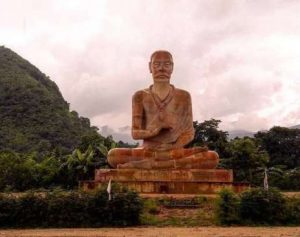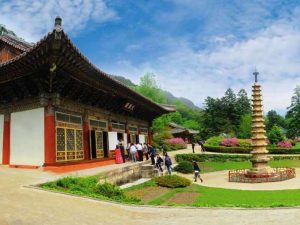
In the first instalment of this trilogy, I introduced the Tiantai school of Chinese Buddhism (天台宗佛教) and explained why and how I personally find it more compelling than the more “devotional” Pure Land Buddhism (淨土宗佛教) and the “cerebral” Chan (Zen) Buddhism (禪宗佛教). The reason for my preference lies in the school’s emphasis on the Lotus Sutra (Saddharmapuṇḍarika Sūtra 妙法蓮花經), which influenced their meditation practices and philosophy. This philosophy—which explains Shakyamuni Buddha’s statement that only bodhisattvas are students of the Buddha, that everyone has the potential to be a Buddha in their present form, that Buddhas are eternal entities, and that there is, in fact, only one Vehicle—emphasizes skillful means (方便, उपायकौशल्य ). In this article, I will unpack what it means to emphasize skillful means in a Chinese Buddhist tradition.
The people who have contributed the most to Tiantai Buddhist thought and practice are the school’s founder, Zhiyi (智顗, 538–597), the school’s Sixth Patriarch, Jingxi Zhanran (荊溪湛然, 711–782), and the great reviver of Tiantai Buddhism in the Song dynasty, Siming Zhili (四明知禮, 960–1028). This article will focus on their philosophical insights.
Philosophically, the greatest idea of the Tiantai Buddhist school is the concept of radical and transformative self-recontextualization, which makes use of the “three truths” theory. The three truths being: emptiness, conventional designation, and the middle (空假中). These three truths are based on chapter 24, verses eight, nine, and 18 of Nāgārjuna’s Mūlamadhyamakakārikā, which formed the basis for his Madhyamaka school of Mahāyāna Buddhism. Verses eight and nine state:
8. All Buddhas depend on two truths
In order to preach the Dharma to sentient beings.
The first is the worldly mundane truth,
The second is the truth of supreme meaning.
9. If one is not able to know
The distinction between the two truths,
One cannot know the true meaning
Of the profound Buddha Dharma.
(Swanson 1989, 1)
This means that there are two ways or levels of viewing “truth” or “reality:” the worldly mundane truth (Sanskrit: saṃvṛtisatya) and the truth of supreme meaning, or ultimate truth (Sanskrit: paramārthasatya).
In order to unpack these two verses, the great Zhiyi relied on Kumārajīva’s Chinese translation of chapter 24, verse 18 of Nāgārjuna’s Mūlamadhyamakakārikā:
यः प्रतीत्यसमुत्पादः शून्यतां तां प्रचक्ष्महे
सा प्रज्ञप्तिरुपादाय प्रतिपत् स्ऐव मध्यमा
yaḥ pratītyasamutpādaḥ śūnyatāṃ tāṃ pracakṣmahe
sā prajñaptirupādāya pratipat saiva madhyamā.
眾因緣生法 我說即是無 [空]
亦為是假名 亦是中道義
[T. 30, 33b11]
(ibid, 3)
In this verse, Kumārajīva writes that everything that arises due to conditioned co-arising can be explained as “emptiness.” Again, this “emptiness” is a “conventional designation,” which is the meaning of the Middle Path.
Zhiyi interpreted this verse to mean that reality is a single whole with three integrated aspects: that of “emptiness” (空), “conventional designation” (假名), and the “middle” (中). Whatever is dependently arisen is empty of a permanent, unchanging essence, which is often identified with the truth of supreme meaning. Conventional designation or existence is the name given to the temporary, transient existence of this phenomenal world as dependently arisen or originated. This is also identified with ultimate truth. The middle is a simultaneous affirmation of both emptiness and conventional existence as aspects of a single integrated reality.
This threefold truth forms the structure of much of Zhiyi’s philosophy, including the four ways of interpreting the Four Noble Truths (四種四諦), the Fourfold Teachings (四教儀), the Ten Realms (or destinies) of existence (十界), the Two Truths, and the final reduction of all into the concept of a single integrated reality that is beyond conceptual understanding. This final reduction is the meditative practice that applies Zhiyi’s theory of threefold truth.
How could we use Zhiyi’s threefold truth theory to arrive at a theory of radical transformative self-recontextualization? As I briefly explained in my previous article, the Tiantai theory of radical transformative self-recontextualization states that any object, person, or event is understood from the all-encompassing perspective of ever-moving space and time. This means that nothing can ever be seen as it is, because one’s perspective is constantly shifting, and that an object, person, or event can always be recontextualized and be designated a new meaning.
Brook Ziporyn, a Tiantai scholar who wrote an article on Tiantai Buddhism for the online Stanford Encyclopedia of Philosophy, from which I have quoted in my previous instalment, likes to use the example of a joke to illustrate this point, but I would like to use a different example. My example is that of pain: the Tiantai appreciation of pain will be the topic of my doctoral dissertation. Pain is something controversial and can be given a different meaning depending on context. On the surface, pain is suffering and thus, something to be avoided at all costs. But, when used deliberately, pain can be an effective deterrent and tool for both discipline and pleasure. It is the ultimate instrument in a lifestyle wherein partners explore power dynamics. So, from one perspective, pain is bad and to be avoided. Yet, when used in the right hands, it can lead to the rectification of improper behavior or the enhancement of sexual pleasure, akin to the addition of spice to food.
The Tiantai Buddhist point here—as with their theory of a threefold truth—is that we shouldn’t ever be attached to how something appears, because there is always more information that recontextualizes the object, person, or event. The only thing that matters is the alleviation of suffering, both for the agent as well as for others.
Another contribution to Tiantai Buddhism by the great Zhiyi is his work on meditation, the Mo-he Zhiguan (摩訶止觀), in which he presents a meditation practice that allows one to grasp all of reality in one short thought: yi nian san qian (一念三千). The “three thousand” (三千, san qian) is derived from the Ten Realms of : Buddhahood, bodhisattva, pratyekabuddha, sravakas, gods, humans, asuras, animals, hungry ghosts, and purgatories multiplied by itself and then multiplied by the Ten Suchnesses (appearance, nature, components, capability, action, causes, conditions, effects, consequences, and ultimate equality and equal ultimacy)—10x10x10=1,000. We then multiply that by the three worlds of the aggregates, sentient beings, and the environment to get 3,000. Contained within the “three thousand” then, is all of existence.
While we meditate, we are supposed to apply the Three Truths, the neither-same-nor-different relation, to this very thought itself. Ziporyn’s online article (2017) walks one through this exercise.
It is therefore clear, that in detaching oneself from dogmatic views of what is, the Tiantai practitioner can better use expedient or skillful means in order to alleviate the suffering of oneself and others. As chapter 24, verses eight, nine, and 18 of Nāgārjuna’s Mūlamadhyamakakārikā state, everything is empty. The only thing that matters is the alleviation of one’s own and others’ suffering. One can best do that by focusing on and emphasizing skillful means.
References
Swanson, Paul. 1989. Foundations of T’ien-T’ai Philosophy: the Flowering of the Two Truths Theory in Chinese Buddhism. Berkeley, California: Asian Humanities Press.
Ziporyn, Brook. “Tiantai Buddhism,” The Stanford Encyclopedia of Philosophy. Spring 2017 Edition. Edited by Edward N. Zalta.
See more
Donner, Neal and Daniel B. Stevenson. 1995. The Great Calming and Contemplation: a Study and Annotated Translation of the First Chapter of Chih-I’s Mo-Ho Chih-Kuan. Honolulu: University of Hawaii Press.
Korean Buddhist monk, Chegwan. 1983. T’ien-T’ai Buddhism: An Outline of the Fourfold Teachings. Translated by the Buddhist Translation Seminar of Hawaii. Edited by David W. Chappell, compiled by Masao Ichishima. Tokyo: Daiichi-Shobō.
Ng, Yu-Kwan. 1993. T’ien-T’ai Buddhism and Early Mādhyamika. Honolulu: Tendai Institute of Hawaii Buddhist Studies Program.
Ziporyn, Brook Anthony. 2004. Being and Ambiguity: Philosophical Experiments with Tiantai Buddhism. Chicago: Open Court Publishing.
Ziporyn, Brook Anthony. 2016. Emptiness and Omnipresence: an Essential Introduction to Tiantai Buddhism. Bloomington: Indiana University Press.
Ziporyn, Brook Anthony. 2001. Evil and/or/as the Good: Omnicentrism, Intersubjectivity, and Value Paradox in Tiantai Buddhist Thought. Cambridge: Harvard University Press.
Related features from Buddhistdoor Global
A Meditation on the Sinitic Lotus School: The Tiantai Trilogy, Part 1
Heirs to the Tiantai Tradition: The Tiantai Trilogy, Part 3











